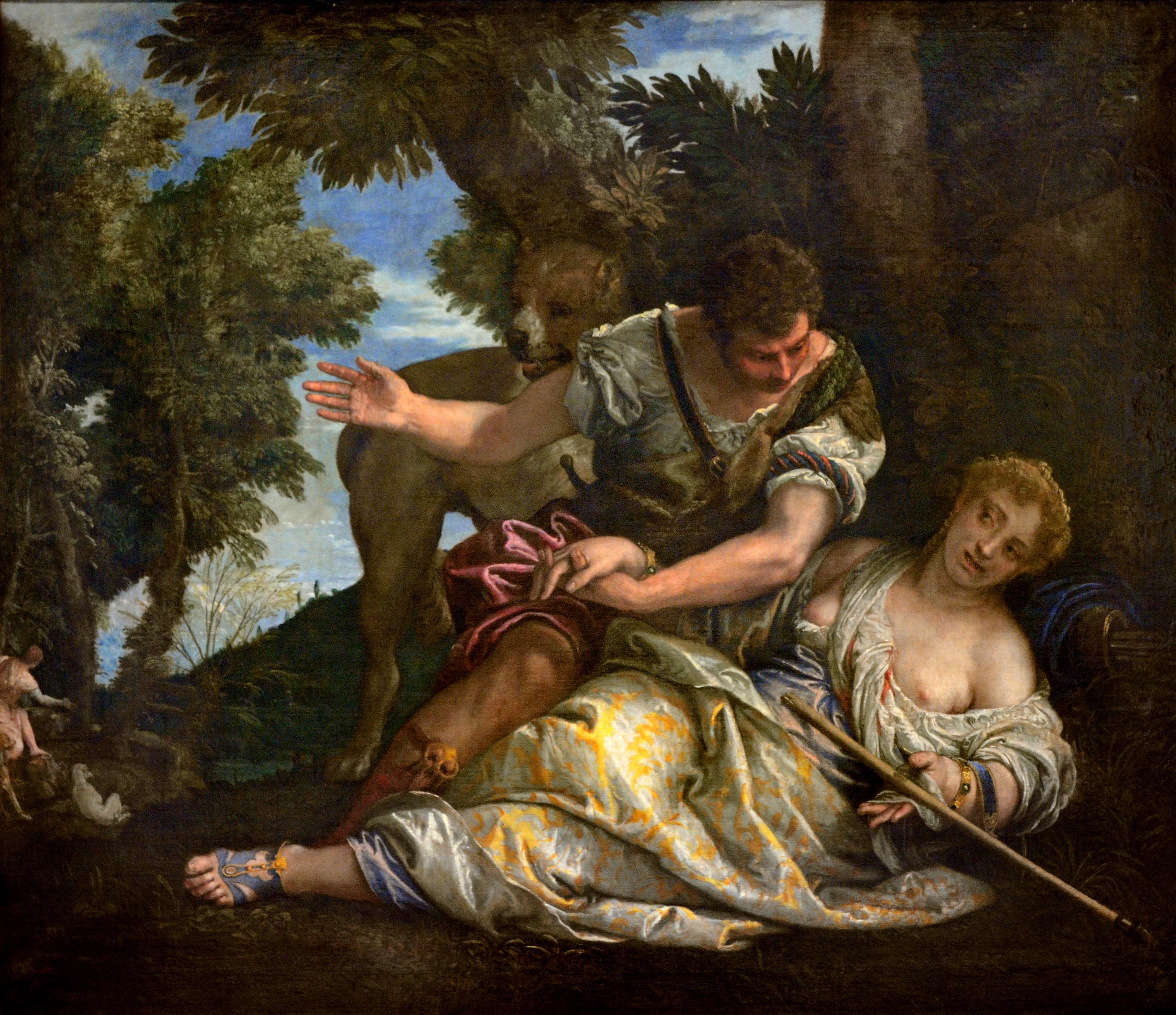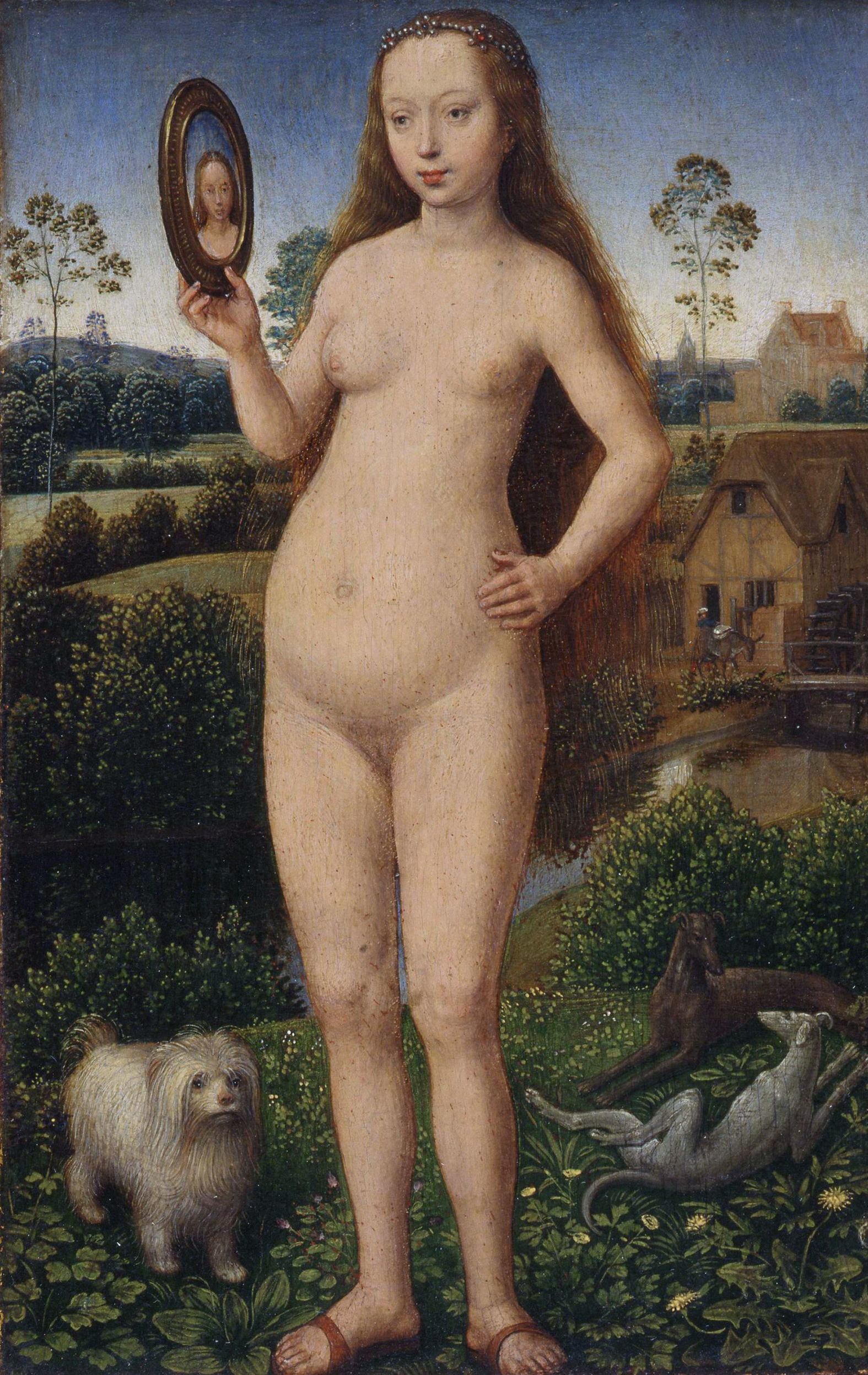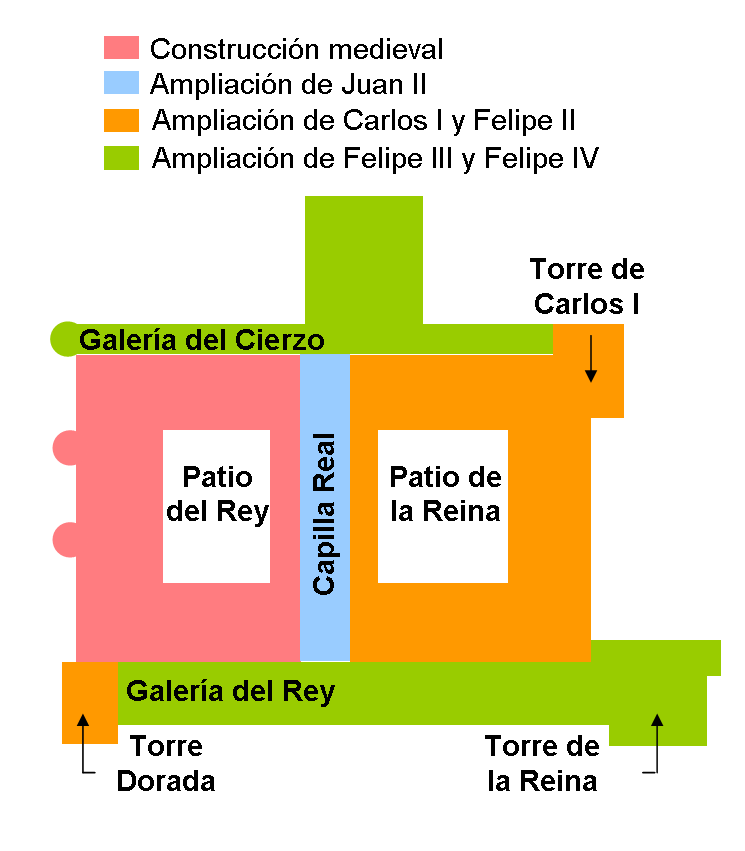|
Venus And Adonis (Veronese, Madrid)
''Venus and Adonis'' is a painting by the Italian late Mannerist artist Paolo Veronese, executed in the early 1580s, now in the Museo del Prado, in Madrid. It is an oil on canvas and its dimensions are 162 cm × 191 cm (64 in × 75 in). The original painting was enlarged by 50 cm in the upper border in the 18th century. This added section was removed in a restoration in 1988, so the work recovered its original horizontal format. Subject and context The painting's subject is taken from ''Metamorphoses'', a narrative poem by the Roman poet Ovid. It portrays the hunter Adonis sleeping in Venus' lap. In front of her is her son Cupid, with a sighthound. Cupid is portrayed while trying to quench the dog's desire to hunt, as Venus had forecast that Adonis would die during a hunt. In the background is a lively green landscape, with a vivid blue sky. The painting was executed after Veronese had spent a period in Rome. He modelled his Cupid on the Hellenistic sculpture of a boy with a go ... [...More Info...] [...Related Items...] OR: [Wikipedia] [Google] [Baidu] |
Paolo Veronese
Paolo Caliari (152819 April 1588), known as Paolo Veronese ( , also , ), was an Italian Renaissance painter based in Venice, known for extremely large history paintings of religion and mythology, such as ''The Wedding at Cana'' (1563) and ''The Feast in the House of Levi'' (1573). Included with Titian, a generation older, and Tintoretto, a decade senior, Veronese is one of the "great trio that dominated Venetian painting of the ''cinquecento''" and the Late Renaissance in the 16th century.Rosand, 107 Known as a supreme colorist, and after an early period with Mannerism, Paolo Veronese developed a naturalist style of painting, influenced by Titian. His most famous works are elaborate narrative cycles, executed in a dramatic and colorful style, full of majestic architectural settings and glittering pageantry. His large paintings of biblical feasts, crowded with figures, painted for the refectories of monasteries in Venice and Verona are especially famous, and he was also the leadi ... [...More Info...] [...Related Items...] OR: [Wikipedia] [Google] [Baidu] |
Musée Des Beaux-Arts De Strasbourg
The Musée des Beaux-Arts de Strasbourg (Museum of Fine Arts of Strasbourg) is the old masters paintings collection of the city of Strasbourg, located in the Alsace region of France. The museum is housed in the first and second floors of the baroque Palais Rohan, Strasbourg, Palais Rohan since 1898. The museum displays works by non-Upper Rhine, Upper Rhenish artists from between the 14th century and 1871 and by Upper Rhenish artist from between 1681 and 1871. The museum owned 1,934 works as of 31 December 2015, this number has substantially increased since (see below). The old masters from the upper-Rhenish area until 1681 are exhibited in the neighboring Musée de l’Œuvre Notre-Dame. Historical overview The first municipal art collection of the city of Strasbourg was the result of the French Revolution, and was a consequence of the expropriation of churches and cloisters. Through the years, the collection, which was founded in 1801, grew by private donations, as well as g ... [...More Info...] [...Related Items...] OR: [Wikipedia] [Google] [Baidu] |
Nude Art
The nude, as a form of visual art that focuses on the unclothed human figure, is an enduring tradition in Western art. It was a preoccupation of Ancient Greek art, and after a semi-dormant period in the Middle Ages returned to a central position with the Renaissance. Unclothed figures often also play a part in other types of art, such as history painting, including allegorical and religious art, portraiture, or the decorative arts. From prehistory to the earliest civilizations, nude female figures are generally understood to be symbols of fertility or well-being. In India, the Khajuraho Group of Monuments built between 950 and 1050 CE are known for their erotic sculptures, which comprise about 10% of the temple decorations. Japanese prints are one of the few non-western traditions that can be called nudes, but the activity of communal bathing in Japan is portrayed as just another social activity, without the significance placed upon the lack of clothing that exists in the ... [...More Info...] [...Related Items...] OR: [Wikipedia] [Google] [Baidu] |
Dogs In Art
Cultural depictions of dogs in art has become more elaborate as individual breeds evolved and the relationships between human and canine developed. Hunting scenes were popular in the Middle Ages and the Renaissance. Dogs were depicted to symbolize guidance, protection, loyalty, fidelity, faithfulness, alertness, and love. As dogs became more domesticated, they were shown as companion animals, often painted sitting on a lady's lap. Throughout art history, mainly in Western art, there is an overwhelming presence of dogs as status symbols and pets in painting. The dogs were brought to houses and were allowed to live in the house. They were cherished as part of the family, and were regarded highly by the upper classes, who used them for hunting and could afford to feed them. Hunting dogs were generally connected to the aristocracy. Only the nobility were allowed to keep hunting dogs, and this would signal status. Dog portraits became increasingly popular in the 18th century, an ... [...More Info...] [...Related Items...] OR: [Wikipedia] [Google] [Baidu] |
1580s Paintings
Year 158 ( CLVIII) was a common year starting on Saturday (link will display the full calendar) of the Julian calendar. At the time, it was known as the Year of the Consulship of Tertullus and Sacerdos (or, less frequently, year 911 '' Ab urbe condita''). The denomination 158 for this year has been used since the early medieval period, when the Anno Domini calendar era became the prevalent method in Europe for naming years. Events By place Roman Empire * The earliest dated use of Sol Invictus, in a dedication from Rome. * A revolt against Roman rule in Dacia is crushed. China * Change of era name from ''Yongshou'' to ''Yangxi'' of the Chinese Han Dynasty. Births * Gaius Caesonius Macer Rufinianus, Roman politician (d. 237) Deaths * Wang Yi, Chinese librarian and poet (d. AD 89 AD 89 (LXXXIX) was a common year starting on Thursday (link will display the full calendar) of the Julian calendar. At the time, it was known as the Year of the Consulship of Fulvus ... [...More Info...] [...Related Items...] OR: [Wikipedia] [Google] [Baidu] |
Annibale Carracci
Annibale Carracci (; November 3, 1560 – July 15, 1609) was an Italian painter and instructor, active in Bologna and later in Rome. Along with his brother and cousin, Annibale was one of the progenitors, if not founders of a leading strand of the Baroque style, borrowing from styles from both north and south of their native city, and aspiring for a return to classical monumentality, but adding a more vital dynamism. Painters working under Annibale at the gallery of the Palazzo Farnese would be highly influential in Roman painting for decades. Early career Annibale Carracci was born in Bologna, and in all likelihood was first apprenticed within his family. In 1582, Annibale, his brother Agostino and his cousin Ludovico Carracci opened a painters' studio, initially called by some the ''Academy of the Desiderosi'' (desirous of fame and learning) and subsequently the ''Incamminati'' (progressives; literally "of those opening a new way"). Considered "the first major art school ba ... [...More Info...] [...Related Items...] OR: [Wikipedia] [Google] [Baidu] |
Venus, Adonis And Cupid
''Venus, Adonis and Cupid'' is a painting created c. 1595 by Annibale Carracci. The painting is in the Museo del Prado, Madrid. Annibale Carracci was one of the most well known Italian Baroque painters of the seventeenth century. The Carracci brothers established an academy of art called Accademia degli Incamminati, which pioneered the development of Bolognese Painting. Annibale Carracci and Caravaggio were among the most influential artists of this century, who through their unique artistic styles led to the transition from Mannerist to Baroque. Annibale was born in Bologna in 1560 and died in Rome in 1609. The painting entered the Spanish royal collection in 1664. ''Venus, Adonis and Cupid'' illustrates the influence of painters such as Titian, Correggio, Veronese, as well as ancient Greek sculptures. ''Venus, Adonis and Cupid'' has three main figures, arranged in a forest landscape: Venus holding Cupid who points at her and Venus looking at Adonis across from her as Adonis ... [...More Info...] [...Related Items...] OR: [Wikipedia] [Google] [Baidu] |
Venus And Adonis (Titian)
A composition of ''Venus and Adonis'' by the Venetian Renaissance artist Titian has been painted a number of times, by Titian himself, by his studio assistants and by others. In all there are some thirty versions that may date from the 16th century, the nudity of Venus undoubtedly accounting for this popularity. It is unclear which of the surviving versions, if any, is the original or prime version, and a matter of debate how much involvement Titian himself had with surviving versions. There is a precise date for only one version, that in the Prado in Madrid, which is documented in correspondence between Titian and Philip II of Spain in 1554. However, this appears to be a later repetition of a composition first painted a considerable time earlier, possibly as early as the 1520s. The Prado version is set at dawn and shows the young Adonis pulling himself away from Venus, his lover. He carries a feathered spear or "dart", a weapon often used in hunting in the 16th century. Th ... [...More Info...] [...Related Items...] OR: [Wikipedia] [Google] [Baidu] |
Royal Palace Of Madrid
The Royal Palace of Madrid ( es, Palacio Real de Madrid) is the official residence of the Spanish royal family at the city of Madrid, although now used only for state ceremonies. The palace has of floor space and contains 3,418 rooms. It is the largest royal palace in Europe. The palace is now open to the public, except during state functions, although it is so large that only a selection of rooms are on the visitor route at any one time, the route being changed every few months. An admission fee of €13 is charged; however, at some times it is free. The palace is owned by the Spanish state and administered by the Patrimonio Nacional, a public agency of the Ministry of the Presidency. The palace is on Calle de Bailén ("Bailén Street") in the western part of downtown Madrid, east of the Manzanares River, and is accessible from the Ópera metro station. Felipe VI and the royal family do not reside in the palace, choosing instead the Palace of Zarzuela in El Pardo. The palace ... [...More Info...] [...Related Items...] OR: [Wikipedia] [Google] [Baidu] |
Royal Alcázar Of Madrid
The Royal Alcázar of Madrid (Spanish Spanish might refer to: * Items from or related to Spain: **Spaniards are a nation and ethnic group indigenous to Spain **Spanish language, spoken in Spain and many Latin American countries **Spanish cuisine Other places * Spanish, Ontario, Cana ...: ''Real Alcázar de Madrid'') was a fortress located at the site of today's Royal Palace of Madrid, Madrid, Spain. The structure was originally built in the second half of the ninth century by the Muslims, then extended and enlarged over the centuries, particularly after 1560. It was at this time that the fortress was converted into a royal palace, and Madrid became the capital of the Spanish Empire. Despite being a palace, the great building kept its original arabic title of ''Alcázar'' (English language, English: "castle"). The first extension to the building was commissioned by Charles V, Holy Roman Emperor, King Charles I (Charles V, Holy Roman Emperor) and completed in 1537. Its exteri ... [...More Info...] [...Related Items...] OR: [Wikipedia] [Google] [Baidu] |
Wilhelm Von Bode
Wilhelm von Bode (10 December 1845 – 1 March 1929) was a German art historian and museum curator. Born Arnold Wilhelm Bode in Calvörde, he was ennobled in 1913. He was the creator and first curator of the Kaiser Friedrich Museum, now called the Bode Museum in his honor, in 1904. Career Bode studied law at the Universities of Göttingen and Berlin, but took an interest in art during his university years. While practicing law in Braunschweig he systematically rearranged the ducal art collections, and visited a number of museums and private collections in Belgium, the Netherlands, and Italy. After studies in art history in Berlin and Vienna, he received his doctorate from the University of Leipzig in 1870 based on his dissertation ''Frans Hals und seine Schule''. In 1871 Bode participated in the so-called " Holbein convention" in Dresden, at which a number of prominent art historians convened to determine which of two versions of Hans Holbein the Younger's ''Meyer Madonna' ... [...More Info...] [...Related Items...] OR: [Wikipedia] [Google] [Baidu] |
Joseph Bonaparte
it, Giuseppe-Napoleone Buonaparte es, José Napoleón Bonaparte , house = Bonaparte , father = Carlo Buonaparte , mother = Letizia Ramolino , birth_date = 7 January 1768 , birth_place = Corte, Corsica, Republic of Genoa , death_date = , death_place = Florence, Tuscany , religion = Roman Catholicism , signature = Signatur Joseph Bonaparte.PNG , burial_place =Hôtel des Invalides Joseph-Napoléon Bonaparte (born Giuseppe di Buonaparte, ; co, Ghjuseppe Nabulione Bonaparte; es, José Napoleón Bonaparte; 7 January 176828 July 1844) was a French statesman, lawyer, diplomat and older brother of Napoleon Bonaparte. During the Napoleonic Wars, the latter made him King of Naples (1806–1808), and then King of Spain (1808–1813). After the fall of Napoleon, Joseph styled himself ''Comte de Survilliers'' and emigrated to the United States, where he settled near Bordentown, New Jersey, on an estate overlooking the Delaware River not far fro ... [...More Info...] [...Related Items...] OR: [Wikipedia] [Google] [Baidu] |










.jpg)